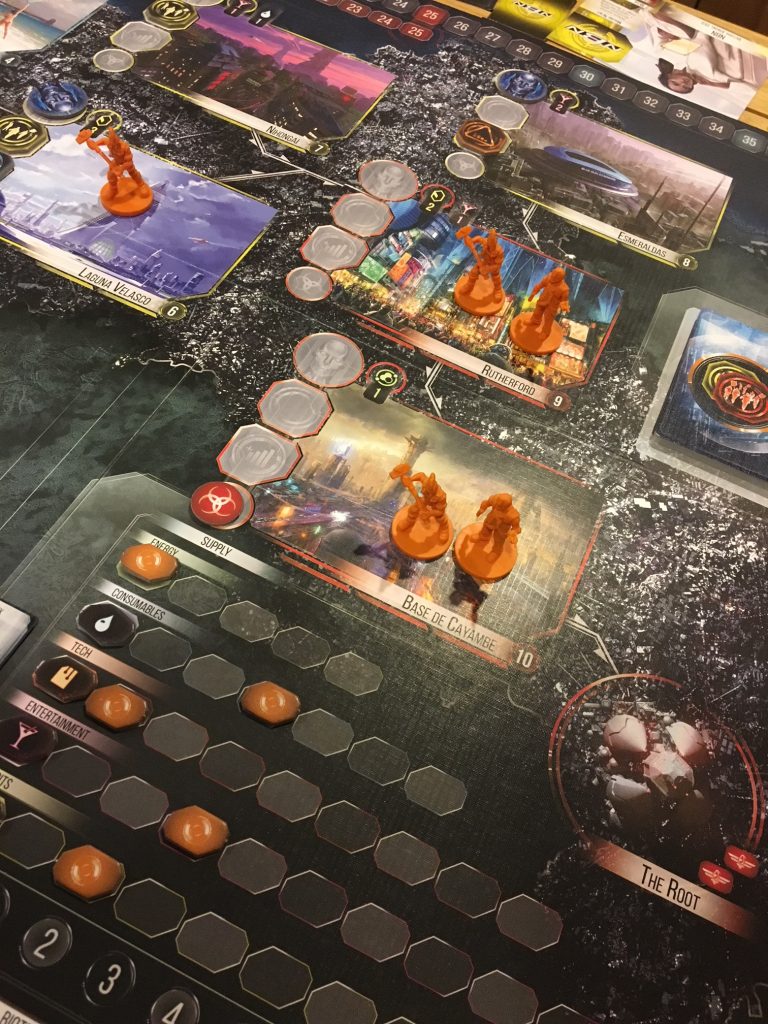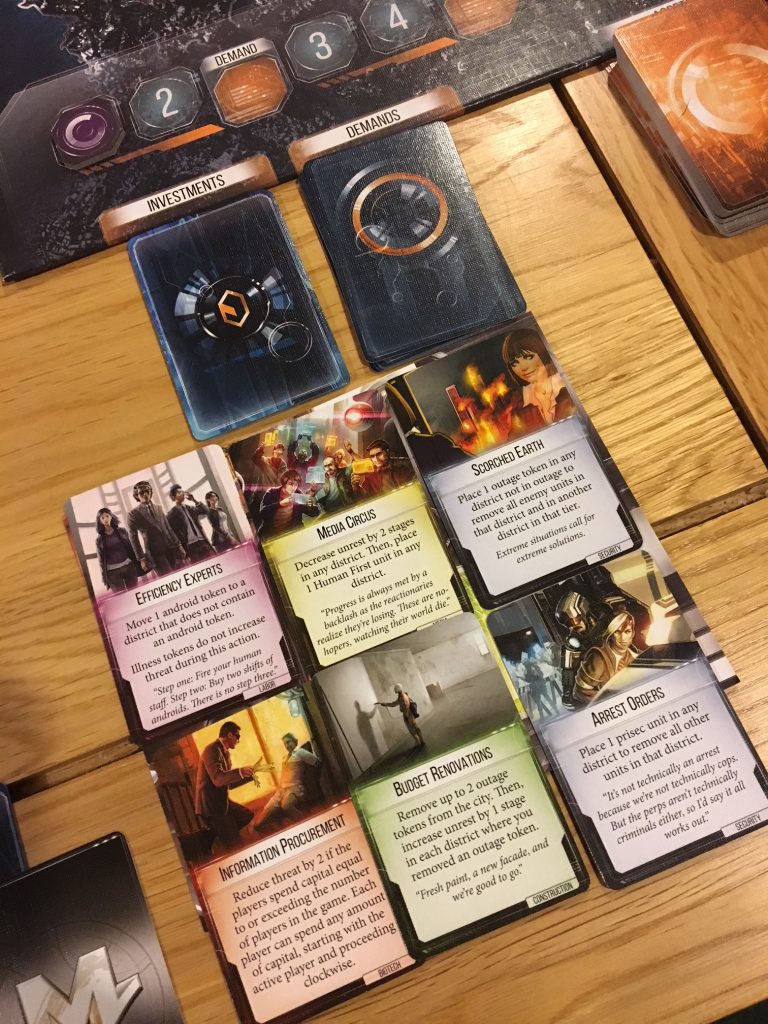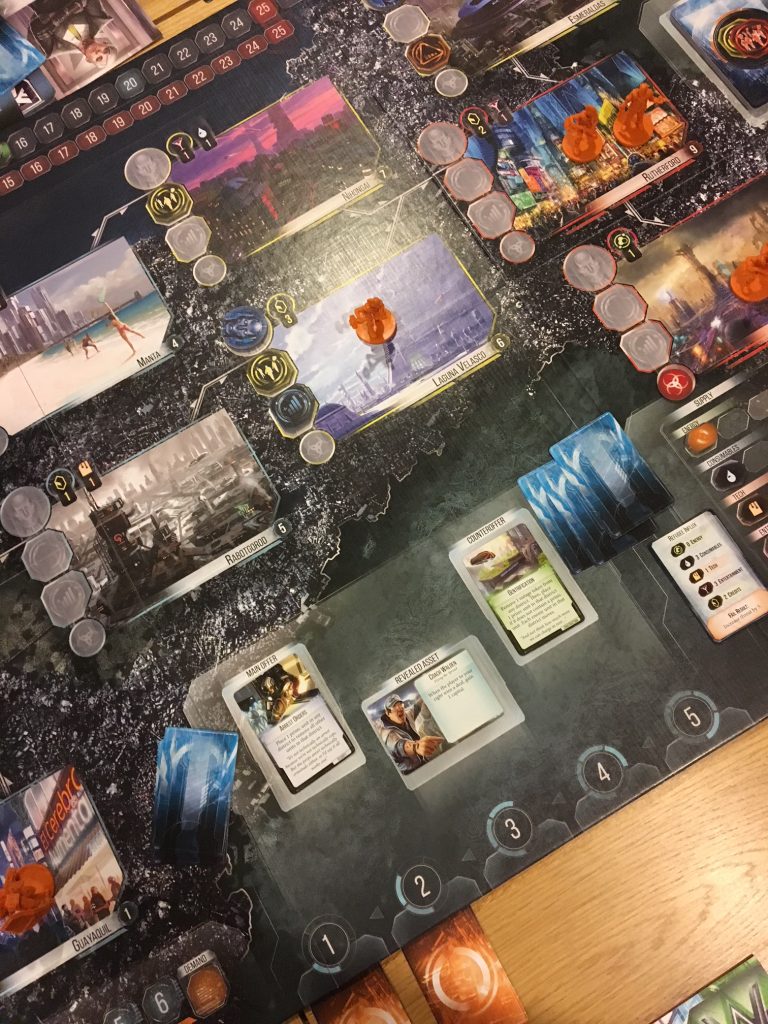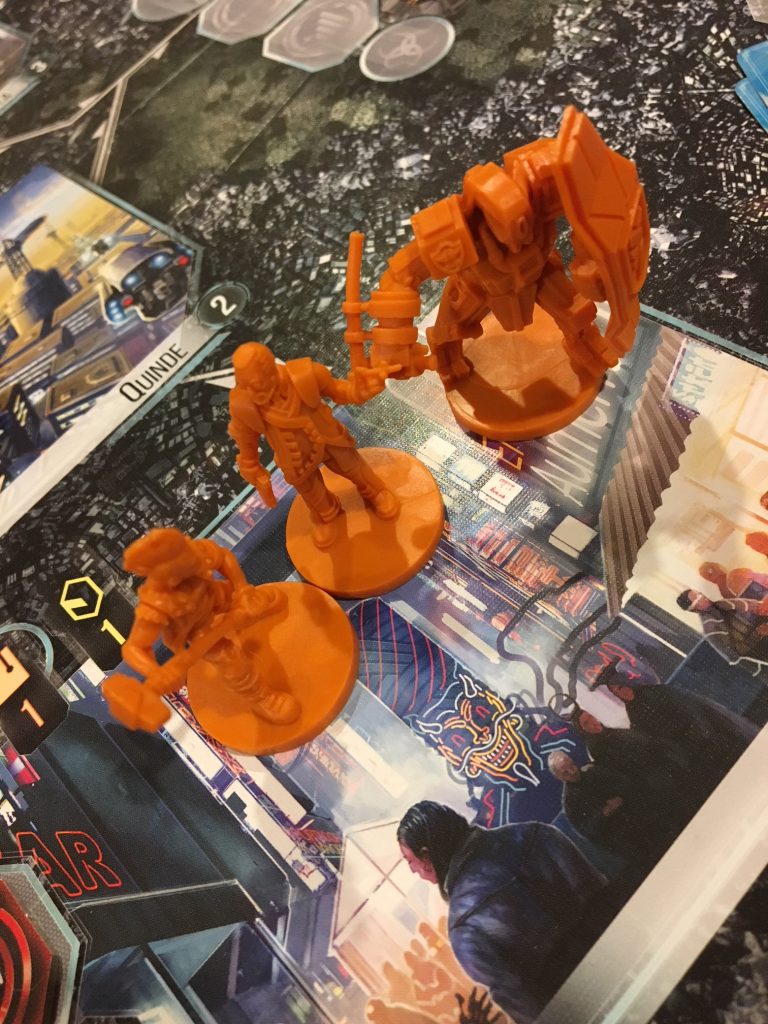In the special economic zone that is the city of New Angeles, there is no such thing as a friendly face. Here, in a cyberpunk world where humans and androids labour side-by-side in the neon-lit shadows of mega-corporate skyscrapers, there is only unrest, corruption and greed. As a game for four to six players, New Angeles pits friends against each other in the roles of six such mega-corporations, each of them with their own rival to beat and all but one of them striving to ensure that the city remains free from the interference of the federal government.
Essentially a complex and thematic negotiation game, New Angeles presents the players with a variable number of rounds (based on cards that are drawn periodically) in which to amass as much capital as possible. All of this is in order to beat a specific, secret rival chosen at random when the game begins. This rival will always be drawn from the corporations in play and may include the player’s own corporation, in which case he or she must score more capital than any two or three other rivals, depending on how many players there are. One player will almost always be The Federalist, whose aim it is to have the city of New Angeles lose its status as a special economic zone and be brought under the administration of the United States — a fate which the other corporations will want to avoid at all costs.

Each of the corporations specialises in a particular area, with most having a specific focus on one key set of actions, including Labour, Biotech, Media, Construction or Security. These actions allow the corporations to influence the way the city produces resources, deals with corruption and unrest and restores service to failing infrastructure. In terms of mechanics, this focus is important, because at the beginning of the game (and on each turn) players must draw three action cards from the relevant action decks as instructed on their corporate cards. In addition to this action deck, each corporation has an emergency power (a standing ability which occurs under certain conditions) and, as the result of successfully winning negotiations, an increasing number of asset cards.
The city of New Angeles itself is split into ten districts, each of which belongs in one of three tiers. Each district produces a primary and a secondary resource, of which there are five. At the beginning of each game (and following each demand phase) a demand card is drawn that sets the tone for the next few turns and forces the players to work together (at least to a certain extent) to meet the stated demands, or else face an increase to the threat tracker. If the threat level reaches twenty five, then the United States steps in and all players lose, except The Federalist (but only if he or she already has twenty five capital of their own.)

To meet the demand, players must manipulate the board using their action cards and other abilities to reduce organised crime, quell unrest (including anti-android campaigners and strikes) increase production, avoid outages and place android workers where they are most needed. Each turn, the active player must propose one of the action cards from their hand and encourage the other players to vote for it based on it being the best option for the city. Should any player disagree, they may propose a counteroffer by placing one of their own action cards in the counteroffer space. The remaining players then vote for one or the other, or propose a further counteroffer by discarding action cards up to the number of counteroffers already on board (usually one, but maybe more) and then placing their counteroffer on top of the one already in place.
Within the reasonable and fairly self-explanatory constraints of the game, players may use any tactic they wish to influence the other corporations to vote for their action. You can promise to vote for someone else’s action next, or you can offer to pay them off in capital. You can even provide them with an existing asset card that you previously acquired. Whatever you do though, you’ll need to propose actions that both help towards your secret objective and that of the wider group, or else they’ll no doubt accuse you of being The Federalist whether you actually are or not.

The player that wins each negotiation gains access to the current asset card (which will be placed face up on the board between the initial offer and the counteroffer) and may add it to their board. Asset cards can bring powerful bonuses and effects, including potentially looking at the rival card that was not taken by any other player, or gaining capital whenever an adjacent corporation meets a certain condition. Some are much more sought after than others, so you’ll want to propose your most powerful and influential actions when such an asset is turned over onto the board.
Once a number of these actions have been proposed and completed, with the corporations each moving pieces on the board around like pawns in their grand scheme, the production phase occurs. Not only does the city produce resources for each district with an android token on it (unless it is striking or suffering from an outage in which case it produces nothing, or has an organised crime figure on it, in which case it only produces its primary resource) but a number of other things happen. Unrest increases wherever androids and humans meet, leading often to protest, then to striking and sometimes, outages. Outages spread upward from one district to the next, as can organised crime or human-first activism, if left unchecked.

Whilst not entirely organic in the way it works, this movement of resources and pieces gives the city of New Angeles a feeling of being a living, breathing city. The people that live there — from the anarchistic humans who rebel against the androids which threaten their livelihoods to the organised crime enforcers who seek to exploit them (just as the player corporations do) — are each trying to carve out a place in the city. Understanding these drivers and how they affect production both this turn and in future turns, then reducing their impact on your profitability is absolutely what New Angeles is all about, even if the bulk of your time will be spent in bartering with your friends.
I said earlier that this movement wasn’t entirely organic, which is the result of the fact that movement of non-player pieces (unless via a player action) only occurs during the production phase. At first, this felt like the inhabitants of New Angeles were slow to react to the pressures being placed upon them, but in fact, the more I played, the more I felt as if this was actually down to the fact that at a megacorporate level, the players only care about escalating issues once they become big enough to matter. A few angry humans is no problem, but humans actively protesting or striking is a bigger problem. Street thugs and gangsters are inconsequential, but an organised gang of criminals taking a cut of district production? That can’t be allowed. When you place yourself in the role of a megacorporation as you do in New Angeles, you have to adjust your perspective to see the bigger picture.

A typical scenario in New Angeles when a demand card is drawn is for the players to take a moment to study the current position of key pieces on the board and to begin a guarded discussion about what must be done. It’s not uncommon for a player to call out the biggest resource demand as an issue, because no single district generates more than two of a single resource, so some demands need to be met with multiple districts. Sometimes, a player will be able to promote the growth of a relevant resource-producing district, which enables it to create an additional resource when it produces. Players will always know how many turns they have to prepare before the next demand phase, so the first player is very likely to push an action that appears to have a high impact on meeting the demand, whilst also furthering their own agenda.
When I first began playing New Angeles, I felt that the restrictive access to only certain kinds of action cards based on corporate focus would result in some players being frozen out on turns where their cards were not relevant. Thankfully, I don’t think I could have been further from the truth, because in practice, the distinction between labor and security cards, for example, is exactly what makes each proposed action interesting in its own right. This results in one or more counteroffers being placed on almost every turn and the cards are designed in such a way that it is very rare for a player to have a hand of complete duds. Even if you do (as the active player it’s a shame because you’ll have to propose something) you can still use them to vote for an action that might benefit you through an asset card you already have, or because it might disrupt your rival etc.

On the subject of well-written cards, I normally touch on the quality of game components much earlier in a review than this, but where New Angeles is concerned, I feel like the pictures speak for themselves. Considering the relatively small size of the box (it’s about half as deep as typical Fantasy Flight Games’ big box products) New Angeles packs in a gorgeous board which folds out into a large rectangle thanks to six sturdy leaves. The miniatures are a good size and made from tough, high quality plastic which (at least in my case) is well-moulded with none of the much-maligned droopy bits which can be an issue in some FFG games. Both the Learn to Play and Rules Reference guides are well written and filled with working examples and all of the card stock and tokens are bright, clear and well made.
Literally my only reservation about New Angeles comes from the fact that it requires a minimum of four players (although there are unofficial rules to enable fewer out there) and really comes into its own with five or six. If you plan to have even a couple of gaming nights over winter with four or more like-minded friends, adding New Angeles to your collection seems like an absolute no-brainer to me. For those who expect to see their return on investment paid back over a longer period, at least the game comes with a slightly lower RRP than most of the flagship FFG games and I would still say it is well worth it. I’ve added it to my shelf as the go-to recommendation for a thematic negotiation game for any group of players over the age of about ten or eleven years old.
A copy of New Angeles was provided for review purposes and can be purchased via 365 Games or through one of the shops found in this handy Store Locator.